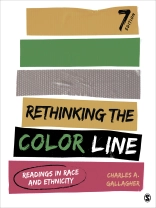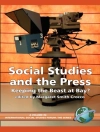Rethinking the Color Line helps make sense of how race and ethnicity influence aspects of social life in ways that are often made invisible by culture, politics, and economics. Charles A. Gallagher has assembled a collection of readings that are theoretically informed and empirically grounded to explain the dynamics of race and ethnicity in the United States. Students will be equipped to confidently navigate the issues of race and ethnicity, examine its contradictions, and gain a comprehensive understanding of how race and ethnic relations are embedded in the institutions that structure their lives.
User-friendly without sacrificing intellectual or theoretical rigor, the Seventh Edition has been thoroughly updated to reflect the current debates and the state of contemporary U.S race relations.
Tabela de Conteúdo
Preface
About the Editor
INTRODUCTION • RETHINKING THE COLOR LINE: Understanding How Boundaries Shift
Part I: SORTING BY COLOR: Why We Attach Meaning to Race
Reading 1. How Our Skins Got Their Color – Marvin Harris
Reading 2. Drawing the Color Line – Howard Zinn
Reading 3. Our Democracy’s Founding Ideals Were False When They Were Written. Black Americans Have Fought to Make Them True – Nikole Hannah-Jones
Reading 4. Racial Formations – Michael Omi and Howard Winant
Reading 5. Race and Ethnicity in America – John Iceland
Reading 6. Racialized Social System Approach to Racism – Eduardo Bonilla-Silva
Reading 7. Why Are Blacks Dying at Higher Rates From COVID-19? – Rashawn Ray
Reading 8. Racism and Health – David R. Williams and Selina A. Mohammed
Reading 9. The Roots of the Widening Racial Wealth Gap: Explaining the Black-White Economic Divide – Thomas Shapiro, Tatjana Meschede, and Sam Osoro
Reading 10: Defining Race: Comparative Perspectives – F. James Davis
Reading 11. A Tour of Indian Peoples and Indian Lands – David E. Wilkins
Reading 12. Panethnicity – Dina Okamoto and G. Cristina Mora
Reading 13. Racialization and Muslims: Situating the Muslim Experience in Race Scholarship – Saher Selod and David G. Embrick
Reading 14. Latinos & Racism in the Trump Era – Stepanie L. Canizales and Jody Agius Vallejo
Reading 15. Institutional Racism Revisited: How Institutions Promote Racism Through Colorblindness – Charles A. Gallagher
Reading 16. Buying Racial Capital: Skin-Bleaching and Cosmetic Surgery in a Globalized World – Margaret L. Hunter
Reading 17. Post-Colorblindness? Trump and the Rise of the New White Nationalism – Ashely “Woody” Doane
Part II: Prejudice, Discrimination, and Racism
Reading 18. Race Prejudice as a Sense of Group Position – Herbert Blumer
Reading 19. Truth: Remarks On the Removal of Confederate Monuments In New Orleans – Mayor Mitchell J. Landrieu
Reading 20. Discrimination and the American Creed – Robert K. Merton
Reading 21. The Place of Race in Conservative and Far-right Movements – Kathleen M. Blee and Elizabeth A. Yates
Reading 22. The Cost of a Black Corpse: The Racism in the Cadaver Trade – Daina Ramey Berry
Reading 23. A Research Note on Trends in Black Hypersegregation – Douglas S. Massey and Jonathan Tannen
Reading 24. Environmental Justice in the 21st Century: Race Still Matters – Robert D. Bullard
Reading 25. Race, Religion, and the Color Line (Or Is That the Color Wall?) – Michael O. Emerson
Reading 26. The Black-White Swimming Disparity in America: Deadly Legacy of Swimming Pool Discrimination – Jeff Wiltse
Part III: Racialized Opportunity in Social Institutions
Reading 27. The Mark of a Criminal Record – Devah Pager
Reading 28. Crack v. Heroin: How White Users Made Heroin a Public-Health Problem – Andrew Cohen
Reading 29. The New Jim Crow – Michelle Alexander
Reading 30. An Unjust Burden: The Disparate Treatment of Black Americans in the Criminal Justice System – Elizabeth Hinton, Le Share Henderson, and Cindy Reed
Reading 31. Ending Mass Incarceration: Six (Not So) Radical Policies for Rapid Decarceration – Natasha A. Frost, Todd R. Clear, and Carlos E. Monteiro
Reading 32. Kristen v. Aisha; Brad v. Rasheed: What’s in a Name and How It Affects Getting a Job – Amy Braverman
Reading 33. When the Melting Pot Boils Over: The Irish, Jews, Blacks, and Koreans of New York – Roger Waldinger
Reading 34. Why So Many Organizations Stay White – Victor Ray
Reading 35. What’s in a Name? For Some Brands, a Racist History Primed to be Toppled – Allegra Frank
Reading 36. Racism and Popular Culture – Danielle Dirks and Jennifer Mueller
Reading 37. The Media as a System of Racialization: Exploring Images of African American Women and the New Racism – Marci Bounds Littlefield
Reading 38. South Asian Characterizations in American Popular Media – Bhoomi K. Thakore
Reading 39. Arabs and Muslims in the Media After 9/11: Representational Strategies for a “Postrace” Era – Evelyn Alsultany
Reading 40. Winnebagos, Cherokees, Apaches, and Dakotas: The Persistence of Stereotyping of American Indians in American Advertising and Brands – Debra Merskin
Reading 41. Taking a Knee – Jeremy Adam Smith and Dacher Keltner
Part IV: How America’s Complexion Changes
Reading 42. It’s Always Been About Exclusion – Caitlin Dickerson
Reading 43. Culling the Masses: The Democratic Origins of Racist Immigration Policy in the Americas – David Scott Fitz Gerald and David Cook-Martín
Reading 44. The Melting Pot and the Color Line – Stephen Steinberg
Reading 45. Who Are the Other African Americans? Contemporary African and Caribbean Immigrants in the United States – John R. Logan
Reading 46. The Arab Immigrant Experience – Michael W Suleiman
Reading 47. Ethnic and Racial Identities of Second-Generation Black Immigrants in New York City – Mary C. Waters
Reading 48. Intermarriage in the U.S. 50 Years after Loving v. Virginia – Gretchen Livingston and Anna Brown
Reading 49. Captain Kirk Kisses Lieutenant Uhura: Interracial Intimacies—The View from Hollywood – Randall L. Kennedy
Reading 50. Discovering Racial Borders – Heather M. Dalmage
Reading 51. Redrawing the Color Line?: The Problems and Redrawing the Color Line?: The Problems and – Redrawing the Color Line?: The Problems and
Reading 52. The Sum of US: What Racism Costs Everyone and How We Can Prosper Together – Heather Mc Ghee
Reading 53. Ten Things You Can Do to Improve Race Relations – Charles A. Gallagher
Appendix: Race by the Numbers: America’s Racial Report Card
Notes and References
Credits
Sobre o autor
Charles A. Gallagher is professor and chair of the Sociology and Criminal Justice Department at La Salle University. His research focuses on social inequality, race relations, and immigration and has published over 50 articles, reviews, and books on these topics. As a nationally recognized expert on race, immigration, and social inequality Professor Gallagher has given over sixty talks on these topics around the country, serves as an expert witness on civil rights cases, and is a frequent media source on these issues, appearing in the press, television, and radio interviews over 100 times. He is currently writing a book on how institutions create self-reinforcing accounts of colorblind egalitarianism that serve to maintain, normalize, and reproduce racial inequality. He recently returned from Fulbright Scholar in the UK where he studied residents’ views on immigration. He also serves as Senior Fellow at Yale University’s Urban Ethnography Project.












